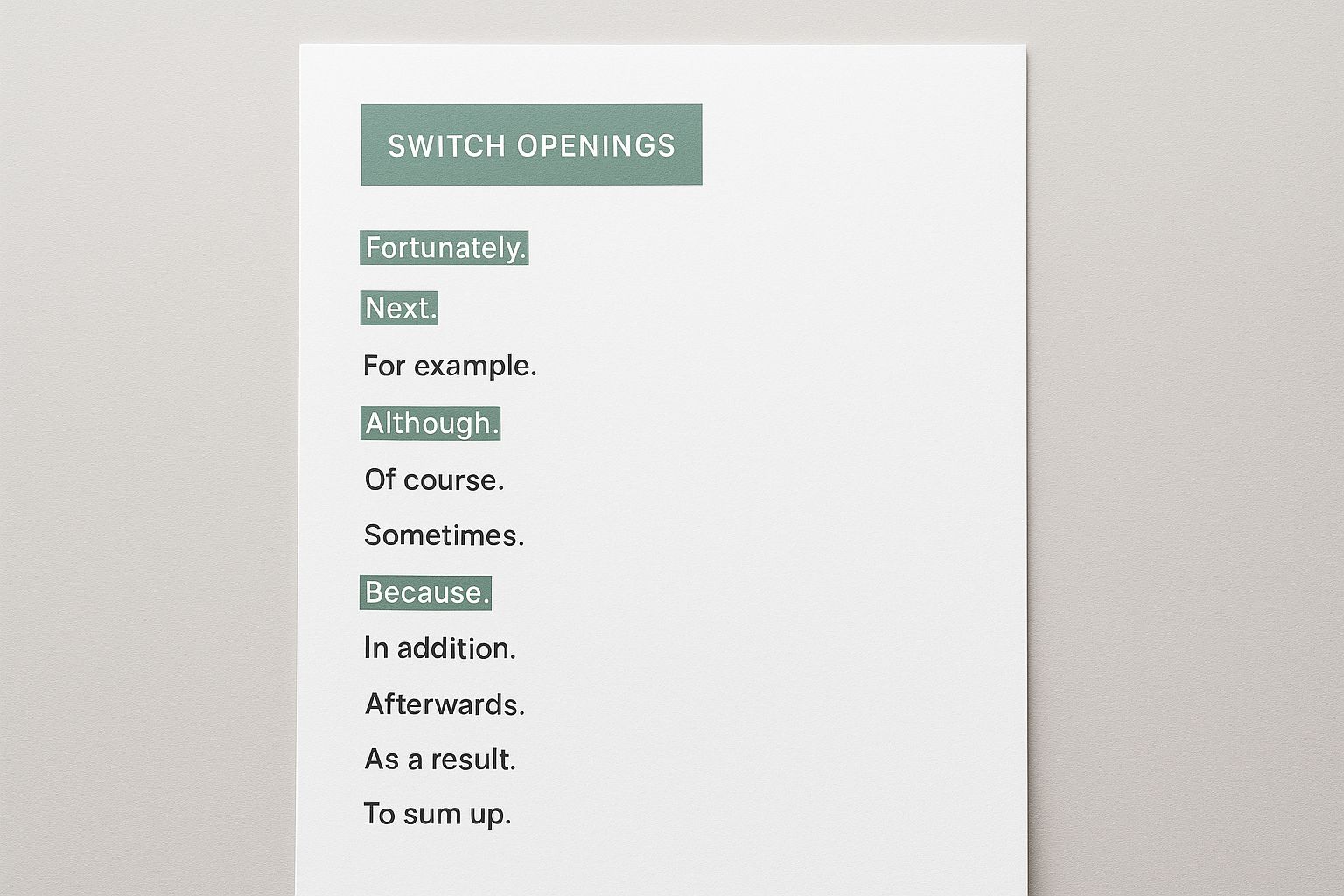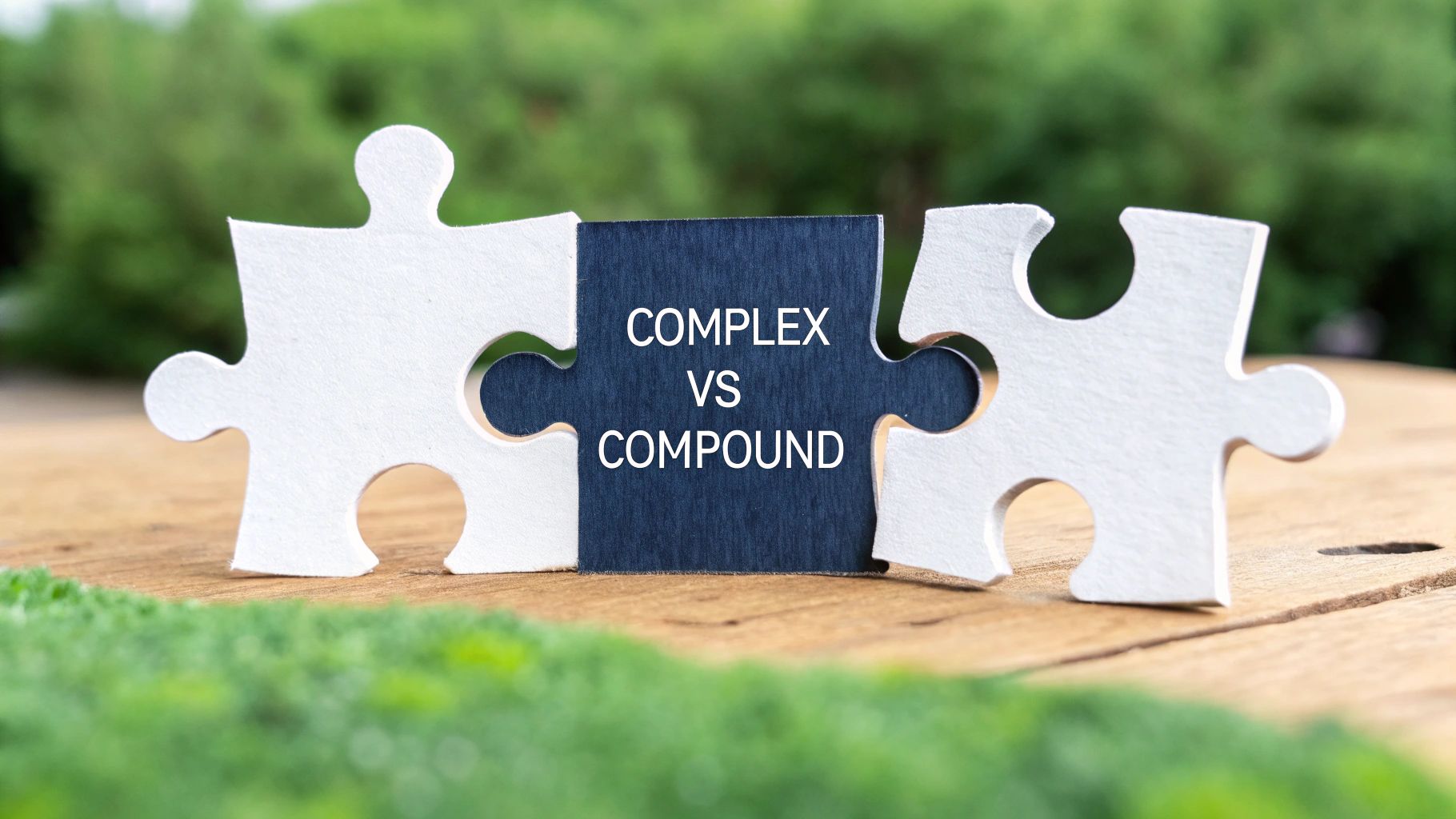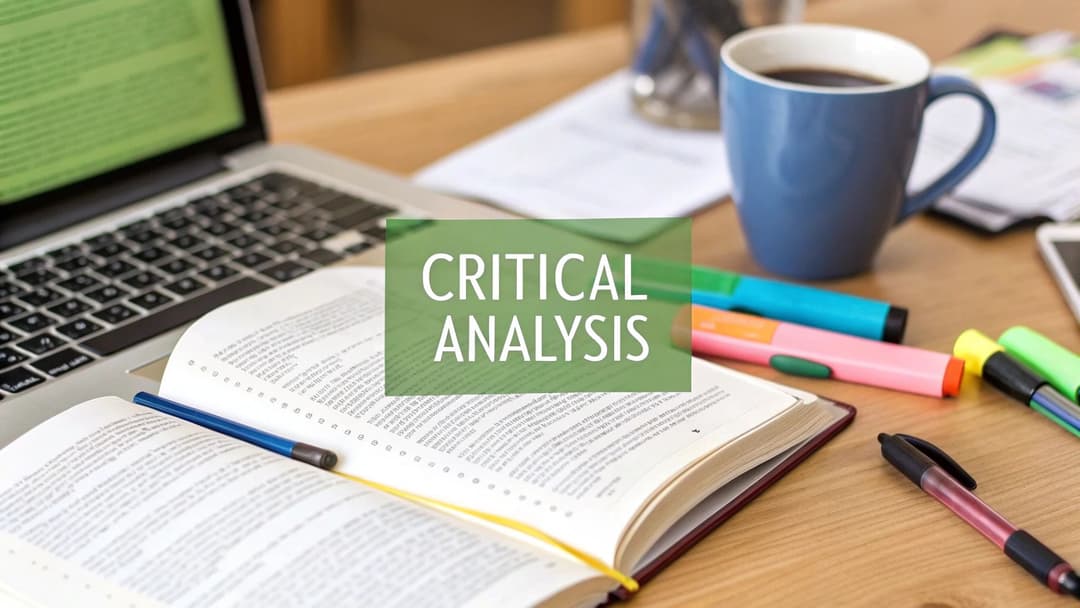
How to Vary Sentence Structure: Boost Your Writing Now
August 28, 2025
Mixing up your sentence structure is one of those things that separates decent writing from great writing. It's about consciously blending different sentence lengths and using the four core types—simple, compound, complex, and compound-complex—to create a reading experience that flows.
This isn't just about avoiding boredom. It's about giving your writing a natural rhythm that pulls the reader along from one idea to the next.
Why Sentence Variety Transforms Good Writing Into Great Writing
Let's get past the basic advice and talk about what's really happening when you vary your sentences. This isn't just about sounding smarter; it's about the psychological effect your words have on the reader.
Think about it. A long string of short, simple sentences feels choppy. Almost childlike. On the flip side, if you hit your reader with one long, complex sentence after another, their brain gets overloaded and they start to tune out. It’s just too much work.
The magic is in the mix.
A short, punchy sentence can land a powerful point with a bit of drama. It’s especially effective right after a longer, more descriptive one. That contrast creates emphasis and gives you control over the pacing, telling the reader exactly what to pay attention to.
The Foundation of Sentence Variation
At the heart of it all are the four fundamental sentence structures. Once you really get a feel for these, you can start using them intentionally to build paragraphs that are both clear and compelling.
They're the basic building blocks of everything you write.
The Four Core Sentence Structures at a Glance
To make this super practical, here’s a quick-reference table that breaks down the four sentence types. Think of this less as a grammar lesson and more as a look at your writer's toolkit.
| Sentence Type | Structure | Best Used For | Example |
|---|---|---|---|
| Simple | One independent clause | Making a direct, clear point | The writer edited the draft. |
| Compound | Two independent clauses | Connecting two related ideas | The writer edited the draft, and she submitted it. |
| Complex | One independent & one dependent clause | Showing cause-and-effect | Because the deadline was near, the writer edited the draft. |
| Compound-Complex | Two independent & one dependent clause | Explaining intricate relationships | Although the deadline was near, the writer edited the draft, and she submitted it on time. |
Each type has a job to do, and knowing which one to pick for a specific moment is what elevates your writing.
This isn't just theory; it’s a strategic way to communicate. And it’s a skill that gets better with practice, which is why it's a huge part of what makes writing effective.
Of course, sentence structure is just one piece of the puzzle. Understanding the broader principles of what makes a good piece of writing is crucial. Learning the best way to write an essay or report can give you a solid framework for almost any project you tackle.
Mastering the Building Blocks of Sentence Structure

If you really want to get a feel for varying your sentences, you have to get comfortable with the foundational tools. We're talking about the four basic sentence types. But don't think of them as rigid grammar rules.
Think of them as different ways to shape a reader's experience. Each one has a job to do. Knowing when to use each type is what turns flat, predictable writing into something that feels alive.
The Power of the Simple Sentence
A simple sentence is just one independent clause. It’s a single, complete thought. Clean and direct.
Example: The company launched its new app.
But don't mistake "simple" for unsophisticated. A short, punchy sentence can deliver a powerful message, especially after a longer, more descriptive one. It cuts right through the noise.
Connecting Ideas with Compound Sentences
A compound sentence links two independent clauses, usually with a conjunction like and, but, or so. This is your go-to for connecting two related ideas that carry equal weight.
Example: The team completed the project, but they missed the original deadline.
This structure creates balance. Instead of two choppy statements, you’re creating a fluid connection that shows how the two thoughts relate. It's a fundamental step toward building more complex ideas.
By mastering these foundational structures, you’re not just following rules; you’re learning how to control the rhythm and flow of your writing. This intentional approach is what separates good writers from great ones.
When you're ready to polish these structures, a quick grammar check and rephrase can be a huge help in making sure every sentence lands perfectly.
Adding Depth with Complex Sentences
Now we’re adding a layer of nuance. A complex sentence brings together an independent clause with at least one dependent clause. That dependent clause can't stand on its own, but it adds crucial context to the main idea.
This is the perfect structure for showing cause-and-effect, contrast, or other relationships where one idea supports another.
- Before (Simple Sentences): The servers crashed. The IT team worked all night.
- After (Complex Sentence): Because the servers crashed, the IT team worked all night.
See the difference? The second example immediately explains why the IT team worked all night. It’s just more efficient and tells a much clearer story.
Weaving It All Together with Compound-Complex Sentences
Okay, this is the most intricate of the bunch. A compound-complex sentence combines at least two independent clauses and one or more dependent clauses. It’s what you reach for when you need to explain complicated situations with multiple moving parts.
Example: Although the marketing team was skeptical, they launched the campaign, and it quickly became the most successful one of the year.
This sentence does a ton of heavy lifting. It introduces a contrast (although the team was skeptical), states an action (they launched the campaign), and reveals the outcome (it became successful).
These sentences are powerful, but you have to use them sparingly. If you overload your writing with them, it can become dense and hard to follow. The real key is balance—using the right structure for the right moment.
Using Sentence Length to Create Rhythm and Emphasis
Great writing isn't just about the words you choose; it's about the music they make. Your primary tool for creating a compelling rhythm that keeps readers hooked is sentence length. When you deliberately mix short, medium, and long sentences, you can control the pace, build tension, and drive home your most important points.
Think of a long, descriptive sentence as a slow, wide-angle camera shot. It sets the scene, explores complex ideas, and pulls the reader into a detailed world. It allows you to weave together multiple thoughts, showing how they connect and build on one another.
But follow that with a short, sharp sentence. It’s a sudden close-up. It demands attention. It lands with impact.
This contrast is one of the most powerful techniques in a writer's toolkit, instantly creating emphasis and making your message unforgettable. The infographic below visualizes how changing your sentence openings—a closely related technique—also contributes to this much-needed variety.

Just as varied openings prevent monotony, alternating sentence lengths creates a dynamic flow that guides the reader's entire experience.
Create Momentum with the Rule of Threes
One of my favorite ways to build momentum is by using a series of three short, punchy sentences. This pattern creates a quick, staccato rhythm that builds anticipation and energy. It pulls the reader forward, getting them ready for a concluding thought.
- Example: The market shifted. Our strategy failed. We needed a new plan.
Each sentence is a quick jab—simple and direct. After establishing this rapid pace, you can deliver the main point with a longer, more detailed sentence that provides the solution or deeper context. This combination just feels right to the reader; it’s psychologically satisfying and highly persuasive.
The strategic use of sentence length and patterns is proven to enhance writing rhythm and emphasis. Cognitive studies show that readers’ brains naturally anticipate a resolution after a series of three parallel elements, making this structure incredibly effective for writers.
This technique is so powerful because it mirrors the natural cadences of human speech, making the text feel more intuitive and engaging from the get-go.
Combine Lengths for Maximum Impact
Learning how to vary sentence structure is about making conscious choices. You don't just write sentences; you arrange them. The goal is to create a texture that feels intentional and, most importantly, serves your message.
Consider this example where the rhythm is completely flat:
- The team analyzed the data from the recent user survey. They discovered several critical issues with the onboarding process. They decided to redesign the entire user flow for new customers. They hoped the changes would improve user retention rates.
It’s grammatically fine, but it’s a slog to read. Now, let's see what happens when we vary the sentence lengths:
- The team analyzed the data from the recent user survey, uncovering several critical issues with the onboarding process. The verdict was clear. They had to redesign the entire user flow, hoping the changes would finally improve retention.
Much better, right? The revised version combines the first two ideas into a longer, more fluid sentence. It then uses a short, impactful sentence for emphasis ("The verdict was clear.") before finishing with a medium-length sentence that concludes the thought. The flow is better, and the key takeaway is much stronger.
This principle is a cornerstone of effective writing, with style guides globally advocating for this approach. To dig deeper, check out this excellent resource on using varied sentence lengths for better writing on wordsbyevanporter.com.
Sentence Length Strategies and Their Effects
To help you put this into practice, think about the different combinations you can use and the specific feeling each one creates. Here's a quick breakdown of common strategies and the impact they have on the reader.
| Strategy | Description | Impact on Reader |
|---|---|---|
| Short, Short, Short, Long | A series of quick, punchy statements followed by a more detailed, conclusive sentence. | Builds tension and momentum, then delivers a satisfying and impactful resolution. Great for storytelling. |
| Long, Short | A detailed, complex sentence that sets a scene or explains a concept, followed by a short, direct sentence. | Creates dramatic emphasis. The short sentence acts like a punchline or a critical takeaway, demanding attention. |
| Medium, Short, Long | A standard sentence to introduce an idea, a short sentence to add a jolt of emphasis, and a long sentence to elaborate. | A balanced and dynamic flow that keeps the reader engaged without feeling too jarring or predictable. |
| Long, Long, Long | A series of long, flowing sentences that connect multiple ideas with complex clauses. | Can create a thoughtful, immersive, or even overwhelming feeling. Use with caution to avoid losing the reader. |
| Short, Short, Short | A rapid-fire sequence of very short, direct sentences. | Creates a sense of urgency, action, or simplicity. It feels fast-paced and is highly scannable. |
Ultimately, there's no single "correct" formula. The best writers mix and match these patterns based on the specific point they're trying to make. Experimenting with these combinations is the key to finding a rhythm that works for your content and your voice.
How to Diversify Your Sentence Openings
https://www.youtube.com/embed/FDLYUv5G19s
Does every sentence you write start the same way? Go ahead, take a quick scan of your last draft. You might notice a sneaky pattern: most sentences probably kick off with the subject. "The team did this." "Our company did that."
It's grammatically fine, of course. But it creates a flat, predictable rhythm that can make even the most interesting ideas feel a little… well, boring.
Learning how to vary sentence structure is often as simple as fixing this one habit. When you consciously change how your sentences begin, you create a more sophisticated flow, add a little punch to key ideas, and guide your reader's attention exactly where you want it. It's a small shift that makes a huge difference.
Start with a Prepositional Phrase
One of the easiest ways to break the subject-first rut is to open with a prepositional phrase. These are just little groups of words that set the scene in time or space, usually starting with words like in, after, with, or through.
- Before: The project manager presented the final report at the quarterly meeting.
- After: At the quarterly meeting, the project manager presented the final report.
See how that little shuffle adds a bit of context before the main point lands? It's a quick edit that instantly makes your writing feel more polished and professional.
Lead with an Adverb
Adverbs—those descriptive words often ending in -ly—are also fantastic sentence starters. When you place one at the beginning, it immediately sets the tone for the entire thought that follows.
- Before: The developers cautiously implemented the new code.
- After: Cautiously, the developers implemented the new code.
That one small change puts all the focus on how the action was done, signaling to the reader that care and precision were involved. It's a great little trick for injecting more personality into otherwise straightforward statements.
By diversifying your sentence openings, you’re essentially creating a more dynamic and engaging reading path. Instead of a straight, monotonous road, you’re building one with interesting turns and focal points that keep your audience invested in the journey.
Use a Dependent Clause to Build Context
Ready for a slightly more advanced move? Try starting a sentence with a dependent clause. This is a phrase that has a subject and a verb but can't stand on its own as a complete sentence. It usually kicks off with a word like although, because, when, or since.
Front-loading your sentence with one of these is perfect for explaining cause-and-effect because it gives the reader crucial background info before you deliver the main idea.
- Before: The campaign went viral after the team incorporated user feedback.
- After: After the team incorporated user feedback, the campaign went viral.
This structure immediately helps the reader understand the "why" behind the "what," which makes your logic much clearer and more persuasive. It’s no surprise that mastering different sentence openings is one of the 8 essential tips for clear writing in 2025. The more you play with these techniques, the more your writing will transform from repetitive to rhythmic.
A Practical Guide to Editing for Sentence Variety

Knowing the theory behind sentence variety is great, but the real skill is baked into your editing process. This is where you transform good ideas into polished, engaging prose.
The goal is to move beyond just hunting for typos. It's time to start looking at your writing's rhythm and flow with a fresh perspective. You can turn revision from a chore into a creative exercise with just a few practical tactics. By actively looking for repetitive patterns, you can spot opportunities to make your writing shine.
Read Your Work Aloud
This is the fastest, most effective way to diagnose a monotonous rhythm. Trust me. Your ears will catch awkward phrasing, clunky transitions, and repetitive sentence structures that your eyes might just glide over.
When you read aloud, you're not just proofreading; you're performing the text.
If you find yourself stumbling over a sentence or running out of breath, that's a clear sign it's too long or convoluted. If a paragraph sounds choppy and robotic, you probably have too many short sentences stacked together.
The act of reading aloud forces you to slow down and experience your writing as a reader would. It’s an old-school trick that works every time because it reveals the true musicality—or lack thereof—in your words.
The Highlighter Method for Visual Feedback
Another powerful technique is to get visual. Grab a few different colored highlighters and assign each color to a sentence length.
Here’s a simple system:
- Yellow: Short sentences (1-10 words)
- Green: Medium sentences (11-20 words)
- Blue: Long sentences (21+ words)
Go through your text and color-code each sentence. When you're done, step back and look at the page.
Do you see huge blocks of a single color? That’s your cue to start mixing things up. This method gives you undeniable visual proof of where your writing lacks variety. This isn't just a quirky trick; it's a strategic approach to improving clarity and reducing monotony, a principle that helps readers better digest complex information. For more on this, check out the research on sentence structure's role in professional communication.
Create a Focused Editing Checklist
Beyond basic grammar, your editing process needs a plan. A targeted checklist helps you focus specifically on sentence structure without getting bogged down by other issues. For a great starting point, our self-editing checklist offers a structured approach to polishing your drafts.
https://naturalwrite.com/blog/self-editing-checklist
Here are a few questions to guide your revision:
- Check Sentence Openings: Have I started three or more sentences in a row with the same word or phrase (e.g., "The," "It," "However")?
- Analyze Sentence Lengths: Is there a healthy mix of short, medium, and long sentences in each paragraph? Where can I combine short sentences or break up a long one?
- Identify Sentence Types: Am I relying too heavily on simple sentences? Where could a complex sentence show a cause-and-effect relationship more effectively?
By incorporating these hands-on tactics, you’ll learn how to vary sentence structure not just in theory, but in practice. Your editing will become more intentional, and your final product will be far more dynamic and readable.
Common Questions About Sentence Structure
As you start consciously playing with your sentences, a few practical questions always come up. It's one thing to understand the theory, but it’s in the actual writing that you start to see where the real challenges are. Let's dig into some of the most common ones.
The goal isn't just to follow a rigid set of rules. It’s to build an instinct for what your writing needs to feel right. These answers should help you handle those gray areas and find your groove.
How Do I Know If I’m Varying My Sentences Enough?
Honestly, one of the best checks is simply to read your work aloud. Your ears will catch monotonous, repetitive rhythms that your eyes might just skim over. If it sounds flat or choppy when you say it, you probably need more variety.
Another great trick is a visual one. Print out a page of your writing and grab a few different colored highlighters. Color-code your short, medium, and long sentences. If you see huge blocks of a single color staring back at you, that’s a dead giveaway you need to mix things up.
The best writing feels effortless and serves the content. Your sentence structure should be a tool that enhances your message and guides the reader, not something that distracts them with forced complexity or jarring simplicity.
This kind of quick self-audit makes it easy to spot where your writing has fallen into a rut. Also, pay attention to how your sentences start. If you see "The," "It," or the subject leading the charge over and over, it's time to find some new ways to begin.
Can I Vary My Sentence Structure Too Much?
Absolutely. The goal is intentional variety, not just random complexity for the sake of it. If you lean too heavily on long, sprawling sentences, your writing becomes dense and hard to follow. Your reader will get lost in a sea of clauses.
On the other hand, a constant stream of short, staccato sentences can come across as simplistic or even frantic. The key is always balance and purpose. Your sentence structure should support the point you're trying to make.
Think of it like this: you're using the right tool for the job.
- Short sentences are perfect for adding punch and clarity.
- Longer sentences are great for explaining complex ideas and showing how they connect.
The structure should feel natural and elevate your message, not become the main event.
Does Sentence Variety Matter in Different Types of Writing?
Yes, it matters in pretty much every kind of writing, but how you apply it will change depending on the context and your audience. The core principle of keeping your reader engaged never goes away.
In a technical report, for instance, clarity is king. You'll likely rely more on simple and compound sentences to keep things straightforward. But a well-placed complex sentence can be perfect for explaining a critical cause-and-effect relationship.
Now, think about a marketing email. A series of short, punchy sentences can build excitement and a sense of urgency. Then, a longer sentence can follow up to deliver the important details. The strategy is always to match your sentence structure to your goal and what your reader needs in that moment.
Ready to transform your AI-generated drafts into polished, human-like writing? Natural Write instantly refines robotic text, improves readability, and ensures your content bypasses AI detection with a single click. Try it free and see the difference at https://naturalwrite.com.


